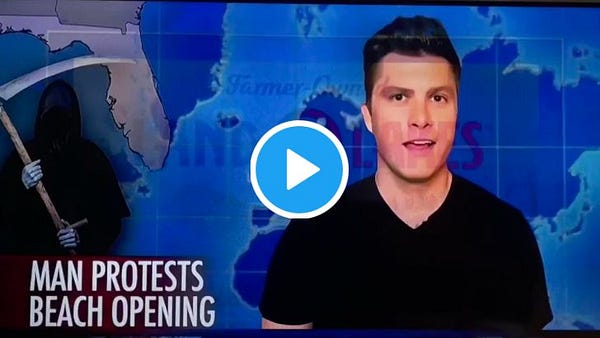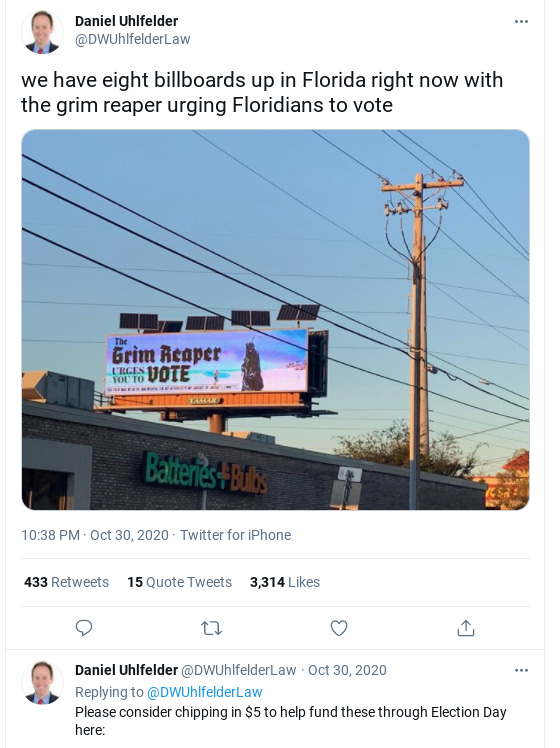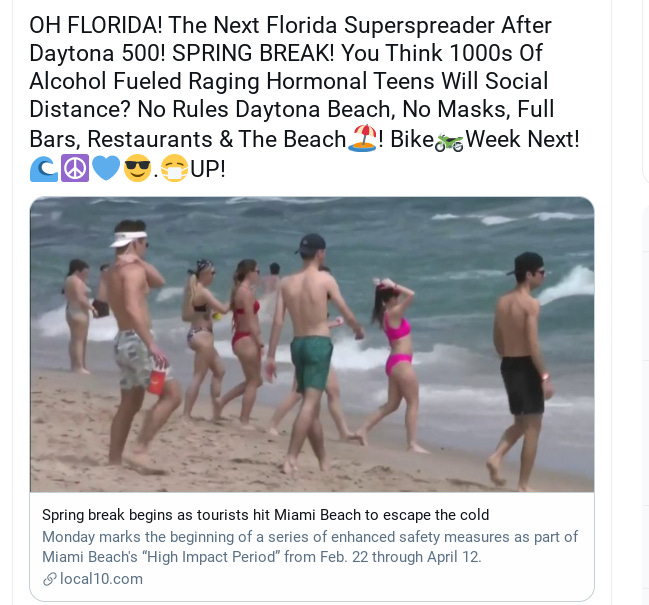Pandemic as Metaphor
The grim reaper who revealed grim truths about our society. (Part two of the misinformation trifecta).
It’s been more than more than four decades since Susan Sontag wrote her famous essays that became the book Illness as Metaphor. She focused especially on cancer and tuberculosis, arguing that we treat diseases as “punitive” curses that descend upon those who do not live up to societal ideals, or, alternatively, that we “romanticize” them—as was done for a long time with tuberculosis.
The myth of TB [tuberculosis] constitutes the next-to-last episode in the long career of the ancient idea of melancholy—which was the artist's disease, according to the theory of the four humours. The melancholy character—or the tubercular—was a superior one: sensitive, creative, a being apart. Keats and Shelley may have suffered atrociously from the disease. But Shelley consoled Keats that "this consumption is a disease particularly fond of people who write such good verses as you have done. . . ." So well established was the cliche which connected TB and creativity that at the end of the century one critic suggested that it was the progressive disappearance of TB which accounted for the current decline of literature and the arts.
She then notes how this evolved to the cancer patient—she herself was one—as imagined in the seventies, too:
However much TB was blamed on poverty and insalubrious surroundings, it was still thought that a certain inner disposition was needed in order to contract the disease. Doctors and laity believed in a TB character type—as now the belief in a cancer-prone character type, far from being confined to the back yard of folk superstition, passes for the most advanced medical thinking. In contrast to the modern bogey of the cancer-prone character—someone unemotional, inhibited, repressed—the TB-prone character that haunted imaginations in the nineteenth century was an amalgam of two different fantasies: someone both passionate and repressed.
This may seem a little quaint to a 21st century reader. It’s not now as widely believed that the cancer patient is someone “repressed” whose inhibitions manifest themselves as cancer. That evolution is partially thanks to patient-led advocacy like that done by Sontag. It’s been more than a century and a half since the germ theory of disease was established, and the 20th century also witnessed great advances in our understanding of cancer.
And yet, psychologically speaking, it often feel like we haven’t moved from the medieval notion (a notion in fact, present in many cultures throughout human history) of illness as sin, or as a punishment that befalls those who stray from the righteous path. In part, of course, this is complicated by the fact that there is indeed often a relationship between our behaviors and our health and well-being. Smokers are a lot more likely to develop lung-cancer, for example, and you can see how often obituaries of lung-cancer victims will note that “they had never smoked” or include some such verbiage. That’s meant to delineate the deceased as the good victim--those upon whom illness came without an observable connection to their (mis)behavior.
Another version of this tension comes up as the “structure and agency” question, common in many social sciences. To what degree do structures of society and our social location within them constrain or enable our life choices and trajectories, and to what degree can individual effort or luck overwhelm the effect of those structures and how? Yes, this is as old as any philosophical discussion of “free will.” But it’s not a superficial or stale discussion. It’s a core philosophical and existential issue as we live our lives.
Perhaps one of the most succinct statements on this question appears this famous passage by Karl Marx in the introduction to The Eighteenth Brumaire of Louis Bonaparte:
Men make their own history, but they do not make it as they please; they do not make it under self-selected circumstances, but under circumstances existing already, given and transmitted from the past. The tradition of all dead generations weighs like a nightmare on the brains of the living.
That’s all well and good, intellectually, to understand. But it’s not something we like to accept as humans, because feeling individually in charge of our destiny is psychologically more comforting. That’s true especially with the rise of ideologies of modernity which step away from accepting “fate” as the driver of our lives. In psychology, that’s called the the “locus of control” and relates to the fundamental attribution error, a relationship I summarized in an Atlantic article in February:
Psychologists talk about the “locus of control”—the strength of belief in control over your own destiny. They distinguish between people with more of an internal-control orientation—who believe that they are the primary actors—and those with an external one, who believe that society, fate, and other factors beyond their control greatly influence what happens to us. This focus on individual control goes along with something called the “fundamental attribution error”—when bad things happen to other people, we’re more likely to believe that they are personally at fault, but when they happen to us, we are more likely to blame the situation and circumstances beyond our control.
What happens when you mix all that with an extremely polarized climate (like that of the United States) facing a terrible pandemic? Well, to continue from the previous installment of this newsletter, you get this:
In my previous Insight post, I looked at the widespread but false belief that Florida was cooking its pandemic books. People thought Florida was lying about its coronavirus numbers, rather than make the mundane observation that it was a middling state, probably due to a combination of factors some of which we may not even fully understand but also can be reasonably linked to its weather. The theory of the state cooking its books seemed partially or fully motivated by opposition to its governor Ron DeSantis, who appears to be a future Republican presidential candidate. (For clarity, I believe one can remain politically opposed to DeSantis and even dislike his handling of the pandemic without needing to believe that the books were cooked).
This post is about the other part of that photo above, the grim reaper. He is an attorney who spent a good chunk of the pandemic prowling Florida’s beaches in that costume, even raising money to purchase billboards with himself on it:
Throughout the last year, there has been a steady drumbeat of news articles and social media posts condemning Florida. The stories and posts feature photos of its beaches, including young people on spring break. Here’s a fairly typical example:
The “Grim Reaper” character comes up all the time:
I found the grim reaper character most telling because it shows how blatant anti-scientific thinking can easily intersect with a version of moralizing attitudes toward illness—very similar to the way Sontag describes how cancer was approached, or how tuberculosis was romanticized. It’s essentially a belief that a perceived sense of superiority about one’s own behaviors confers better protection against the illness/this pandemic, and that disease is something that descends upon those who have the wrong kind of fun. People, for example, who are visible on the beach, especially young people.
At this point, you might be thinking that, of course disease and life choices are connected. Of course! True. To some degree. With different validity for different aspects of different diseases and health outcomes. Many things are true at once: fresh vegetables and less processed food seem to provide better health outcomes, for example, while lack of exercise and fresh air are detrimental. Are these choices? Yes, no, maybe, all of the above, in complicated ways. Many poorer neighborhoods lack access to affordable fresh foods, and it is easier to keep oneself to a diet of fewer processed food when one has time and resources. Plus, as almost anyone can easily attest to even without citing many studies, people have different levels of individual susceptibility to different diseases or healthier behaviors, and different reactions to it. One can easily acknowledge and keep that complexity in mind, while also realizing the ridiculousness of what happened over the last year with the focus on parks and especially beaches.
I first wrote about the need to keep beaches and parks open as early as April of 2020. I will put the details in the next post, but for the moment let’s just put this here as context: we’ve long known that outdoor transmission is relatively rare. Later in 2020, frustrated, I wrote another article pleading to stop scolding beach-goers in the summer. It was among the safest activities we could do while we faced perhaps another full year of social distancing and increased isolation.
Sometimes people suggest that it’s okay to focus our scolding on beaches because people who travel to beaches often do unsafe things as well (like indoor dining), but that seems particularly contortionist. If we are trying to tell people that indoor dining is unsafe, the most obvious way to do this seems to be to say… that indoor dining isn’t safe, to encourage alternatives, and to focus on providing protections to restaurants-workers. One study found that line cooks faced among the highest rates of deaths from COVID, so just saying “order take out” isn’t enough.
Also, to the degree that infrequent outdoor transmission does occur, it seems that the risk is higher if is in prolonged close-contact (such as talking) with someone outside of one’s actual pandemic bubble (like the household). The sunshine helps deactivate the virus, the wind/air helps quickly dilute it, and people on beaches do not normally sneak up on strangers to yell at them at length.
Unless, I guess, you are an attention-seeking attorney dressed up as the grim reaper, intent on baselessly lecturing, scolding and ridiculing people while they do something otherwise very safe: then you are actually adding risk to this otherwise safer activity.
Just looking at the photos he posts shows the ridiculousness of his campaign, him on vast beaches, occasionally approaching people minding their own business (with camera crews trailing him, out of shot):
I will not post all the examples, but if you go through his own feed and the coverage from others, you’ll see that it is full of videos of this individual scolding people on the beach. He especially enjoys posting videos when the people he’s harassing say something stupid in response or turn out to be Trump supporters.
This attorney also repeatedly confidently predicts superspreading from outdoor events and referring to the attendees as members of a “death cult.” There hasn’t been any follow-up when the mass Covid-19 outbreaks he predicts don’t come to fruition, as far as I can tell. (And he’s made no such comments on the mass outdoor Black Lives Matter protests over the same time period—to be clear, from what we can tell, those protests, too, also did not lead to any outbreaks or rise in cases)
In essence, he spent the year as probably the biggest risk to the people he was harassing on the beaches he frequented in a ridiculous costume making absurd claims.
What did he get in response to this terrible attitude and risky behavior ? Adulation from traditional media, and a lot of retweets and likes on social media:






Why does this matter, besides being infuriated by the smugness of that anti-science attorney harassing individuals? Because it’s part of a big pattern. I have a few Twitter threads where I’ve provided examples of people being shamed, scolded, facing hostility and even being trampled by horses for just being on the beach or ata park. There have been many stories of superspreading, outbreaks and surges that are illustrated by pictures of beaches and parks.



The damage is two-fold. First, it misleads people into thinking a safe activity is in fact unsafe. It likely increases unsafe behaviors, like meeting indoors, out of sight of the scolders.
But there’s something worse: it creates victim-blaming. Take a look at this exchange from today:
Last week, in the article I wrote about the latest set of outbreaks in the United States, including around Michigan, I suggested sending more vaccines to such areas. I got a lot of responses asking why should we send more vaccines to a place that’s experiencing a surge,—since it must be their fault.
Even a cursory look at the statistics of this pandemic reveals that most of the victims are poorer and people of color, especially Hispanic or Black. They’re what we’d call frontline workers, who cannot just stay home amid their crowded housing conditions.
Today, prominent scientist and physician Eric Topol asked this question:



Maybe, just maybe, if we were less focused on viewing illness as the wages of sin, we could do a better job noticing the victims and surging vaccines to areas experiencing outbreaks.









It's wild how the tribal dynamics are so self-reinforcing. Even putting emotion aside, nuance can feel like signal-weakening, so people over-signal to push the equilibrium. Like trying to do systems thinking, but without guardrails like trust and good faith.
I find the use of the Grim Reaper obnoxious, but to me it's not the salient metaphor that comes out of the pandemic. Rather, the anti-scientific metaphor concerns the science-denying anti-maskers who claim it's a matter of freedom; the people who believe COVID-19 is a Democratic hoax; the folks who associate the response to disease with the imposition of socialism on the US. These images are far more strongly embedded, a bizarre form of "Live Free or Die." Reading interviews with nurses in South Dakota who reported some patients' final words before intubation were that it was all a hoax turns my sense of rationalism to jelly.